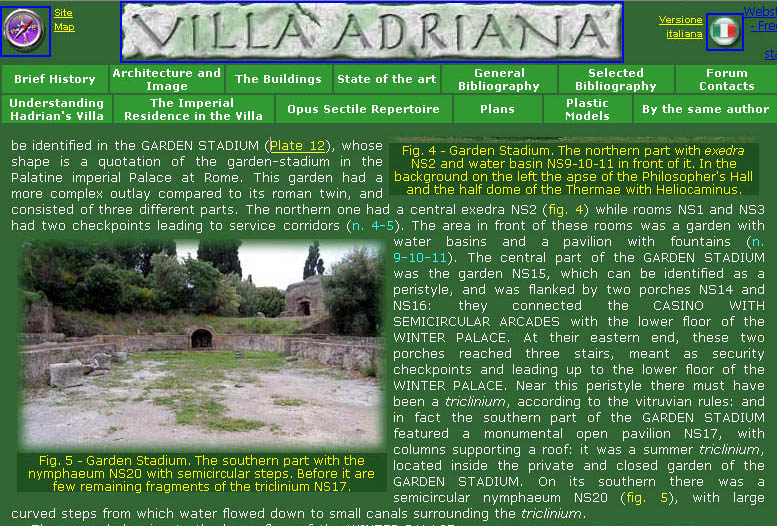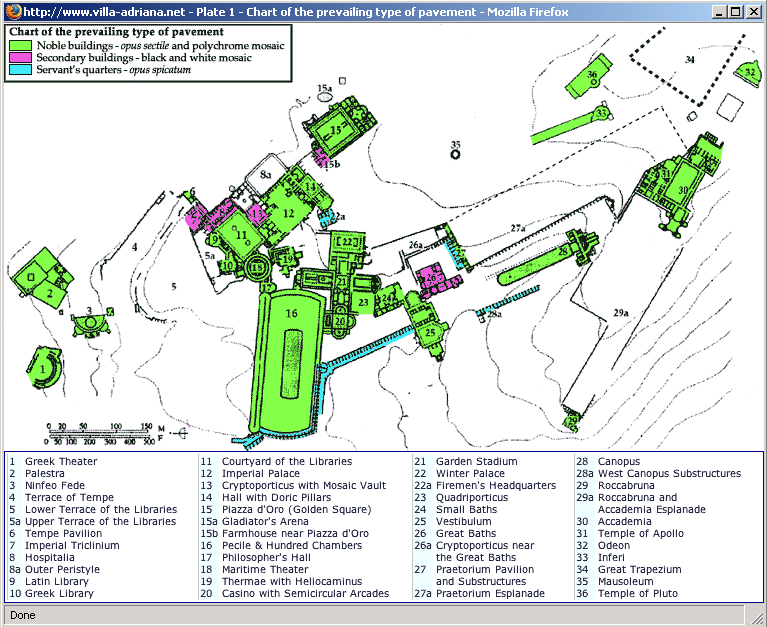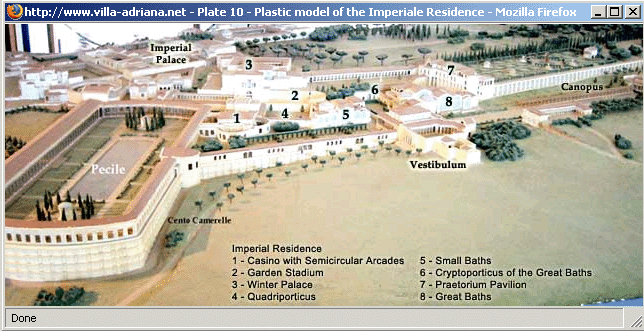Vol. XIX, No. 2

Fall, 2006
|
Vol. XIX, No. 2 |
|
Fall, 2006 |
Website Review: Villa Adriana; Hadrian's Villa near Tivoli, Rome
Susan C. Jones
Authorship: Marina De Franceschini.
Site host: No host or sponsors are mentioned on the home page.
Peer review, permanence: No statements appear as to peer review policies, date of first appearance, revision dates, the site's permanence or its provisions for archiving.
Site maintenance: Pages have been added since the site first came under my notice approximately a year ago when many of the links led to an "under construction" message. Ms. De Franceschini's name is the only one that appears on the home page.
Excavations and studies of the site at Tivoli have been carried out periodically since Biondo Flavio identified it as Hadrian's Villa at the end of the 15th century. As with many long-known Roman sites there is an abundance of material available but little that can be considered as adequately documented by current archaeological standards. Those excavations that have been carried out focused on individual buildings and frequently left the intervening spaces unexplored. This, along with a lack of recorded stratigraphy and findspots for the older explorations of the villa area, compounds the difficulty of producing a clear picture of the relationships among the structures encompassed by the villa. I will return to this point later.
This web site provides an organized synopsis and history of Hadrian's Villa in a presentation that is both accessible to the general public and useful to students of Imperial Rome.
This is a bilingual site (Italian and English) based on Ms. De Franceschini's research.1 Included among its pages are: a history of the excavations, plans of the villa complex that highlight its organization and infrastructure, discussions and reconstructions of various buildings, photographs of the remains, an extensive bibliography and contact information for both tourists and scholars.
The design of the site is simple and effective. The home page contains the briefest of information about the villa and the authorship of the web site. The banner across the top of the page provides the fundamental navigation and remains the same for many subsidiary pages. This banner provides access to a site map, Italian and English versions of the pages and thirteen links to topical information:
Most links open within the primary window with the navigation banner as the universal header. A single secondary window is used for the individual structure plans and reconstructions. This simple, straight-forward approach allows users to set up their own window structure through their browser settings if so desired.
There are links embedded within discussions that will bring up related text and plans on the site.

The design of the pages, with their green background and pale text colors are easy to read. Extensive photographs of the villa taken by the author herself illustrate all the pages. These images lend support to her descriptions and arguments about the functions of the various structures that make up the villa. The text has been color-coded with basic text in white, references to images and their captions in yellow and feature numbers used on the plans in aqua. The clickable links to plates are the same yellow as references to the photographs embedded within the page, as well as the captions under them. I found this somewhat confusing at first, but it did not take long to become acclimated to this pattern.
There are inconsequential typographical errors, misspellings and idiomatic wordings, but none of them interfere with the presentation or understanding of the material.
Teasing any sense of organization from the remains of Hadrian's Villa is a monumental, if not impossible task. With a total area of approximately 120 hectares (just over half state-owned and the rest in private hands) and over 900 known "rooms," the physical remains of Hadrian's Villa are obviously large and complex. For comparison, the city walls of Pompeii enclose under 70 hectares.2 To add to the complexity there are few contemporary written descriptions, over 1500 years of removal of bits and pieces by local builders, lime-kiln operators, treasure hunters, archaeologists, etc. and centuries of speculative interpretations. Archaeologists interpreting this complex must apply their individual expertise, experience and intuition to the physical remains for their syntheses. Arguments are inevitably by analogy; as a result such syntheses vary in detail. Each probably contains some "truth," but none can be said to have the final word.
Ms. De Franceschini uses primarily decorative
schemata, levels of craftsmanship and exotic architectural elements to organize the remains. This approach
provides a simple scheme that makes intuitive sense. (Although the resulting scheme itself is simple, this does
not imply that the analysis was simplistic.) The highest skill levels, most expensive
material and most elaborate decorations are seen in the areas frequented by the imperial family,
and the meanest can be seen in the servants' quarters. There is also a middle level which she has assigned to important
functionaries. Her three categories are:
* noble quarters - buildings and areas for the use of imperial family centered around the
"Imperial Residence"3
* secondary quarters - buildings housing high-ranking officials, such as liberti,
priests, bodyguards and officers
* and servant's quarters - rooms built within the substructures and the retaining walls.
The actual structures included within these categories can be seen most clearly in Plate 1 (the chart of the prevailing
type of pavement) on the "Plans" page, with Plates 9 and 10 showing the "Imperial Residence."

Figure 2 - Plan of the Villa structures included in Ms. De Franceschini's three categories.

Figure 3 - Reconstruction of the "Imperial Residence."
The logic behind Ms. De Franceschini's classifications is clearly explained in the "Understanding Hadrian's Villa" discussion. The overwhelming majority of features are classified as belonging with the noble quarters. This majority may only reflect the inherent bias in historical research and excavations towards the more decorative sections of the villa's grounds, or it may equally be a comment on the use of architecture to support the image of the Emperor.
Each section of the web site has a different organization in its discussions of the features, one that makes sense to the individual analyses. For example, the discussions of the structures within "The Buildings" section are organized by the villa's internal geography: an eastern section, a central imperial section and an upper section. This organization mimics what a visitor sees from the entrance to the furthest reaches of the state-owned sections of the villa. The text describes the major structures and their known excavation history. This guidebook organization works well as an introduction to the site.
Unfortunately, no cross-links exist among the various analytical sections so that readers must provide their own search mechanisms to find the complete interpretation of a given feature. For instance, there are no links between the discussion of the structures comprising the "Imperial Residence" on that page and those on "The Buildings" page. Each discussion has its own unique illustrative photographs. Furthermore, only discussions in the "Imperial Residence" are linked to detailed plans of structures, as seen in figure 4. Therefore to get a complete picture of the "Imperial Residence," you must access both pages separately.

Figure 4 - Plan of the Garden Stadium - Plate 12. See figure 1
for a section of the discussion of this area.
There is some repetition of information among the various sections of the site. This repetition, however, is compatible with the non-linear nature of good web presentations and is helpful for the scholar who is not intimately familiar with Hadrian's Villa.
This is clearly a work of a dedicated scholar who succeeds in bring order to a complex site. The web site is extensive and the presentation well-suited to the non-linear format of web research. The Imperial Residence is discussed in greater detail than the other areas of the villa, but areas such as the Maritime Theater and Canopus, are not ignored, and an extensive bibliography is supplied for those who wish to investigate the villa in greater depth. Furthermore, Ms. De Franceschini's use of traditional nomenclature for the features allows students to relate the images and information on the page with discussions of the villa from other sources.
-- Susan C. Jones
To send comments or questions to the author, please see our email contacts page.
1. Some of this research has been published in her 1991 book, Marina De Franceschini, Villa Adriana - Mosaici, pavimenti, edifici (Rome 1991) and in later publications and presentations. Return to text.
2. W.L. MacDoanld and J.A. Pinto, Hadrian's Villa and Its Legacy (Yale University Press, 1996) 29, 183. Return to text.
3. Ms De Franceschini makes a distinction between the "Imperial Palace" and the "Imperial Residence." The Palace incorporates sections of the older Republican-era villa, and the functions of many of its rooms can not be ascertained from the remains. Return to text.
For an index of other CD and Web site reviews available on the Web pages of the CSA Newsletter, see the review index.
For other Newsletter articles concerning the use of electronic media in the humanities, consult the Subject index.
Next Article: High Dynamic Range Photography
Table of Contents for the Fall, 2006 issue of the CSA Newsletter (Vol. XIX, no. 2)
 Table of Contents for all CSA Newsletter issues on the
Web
Table of Contents for all CSA Newsletter issues on the
Web